Republic of Georgia: A hike through wine’s birthplace is a yummy treat but Georgians would like a bigger bite

TBILISI, Republic of Georgia — The statue of St. George stands high above Freedom Square in this charming riverside capital. Like a gold beacon, the country’s namesake sits astride his bucking horse as his sword slays a dragon beneath him. Until 2006, the statue was Vladimir Lenin, another man who slayed a few dragons then created a nation of them. He also set the stage for one of Georgia’s favorite native sons, Joseph Stalin.
Georgia could use another hero, and maybe one not so violent. A country of only 3.7 million people, its tourism is starting to boom. More than 2.7 million tourists came in 2016 bringing in $2.16 billion. However, broiling underneath its growing international reputation like molten lava is turmoil and unrest. Keep in mind Georgia was once called “The Tuscany of the Soviet Union.” Sure, that’s a little like being the best violinist in Nebraska but after nearly two weeks in Georgia I can confirm that its food and wine are planetary stalwarts. Add in some mountain scenery and spectacular hiking in the highly underrated Caucasus mountains and you have an outdoors/culinary vacation few countries its size can match.
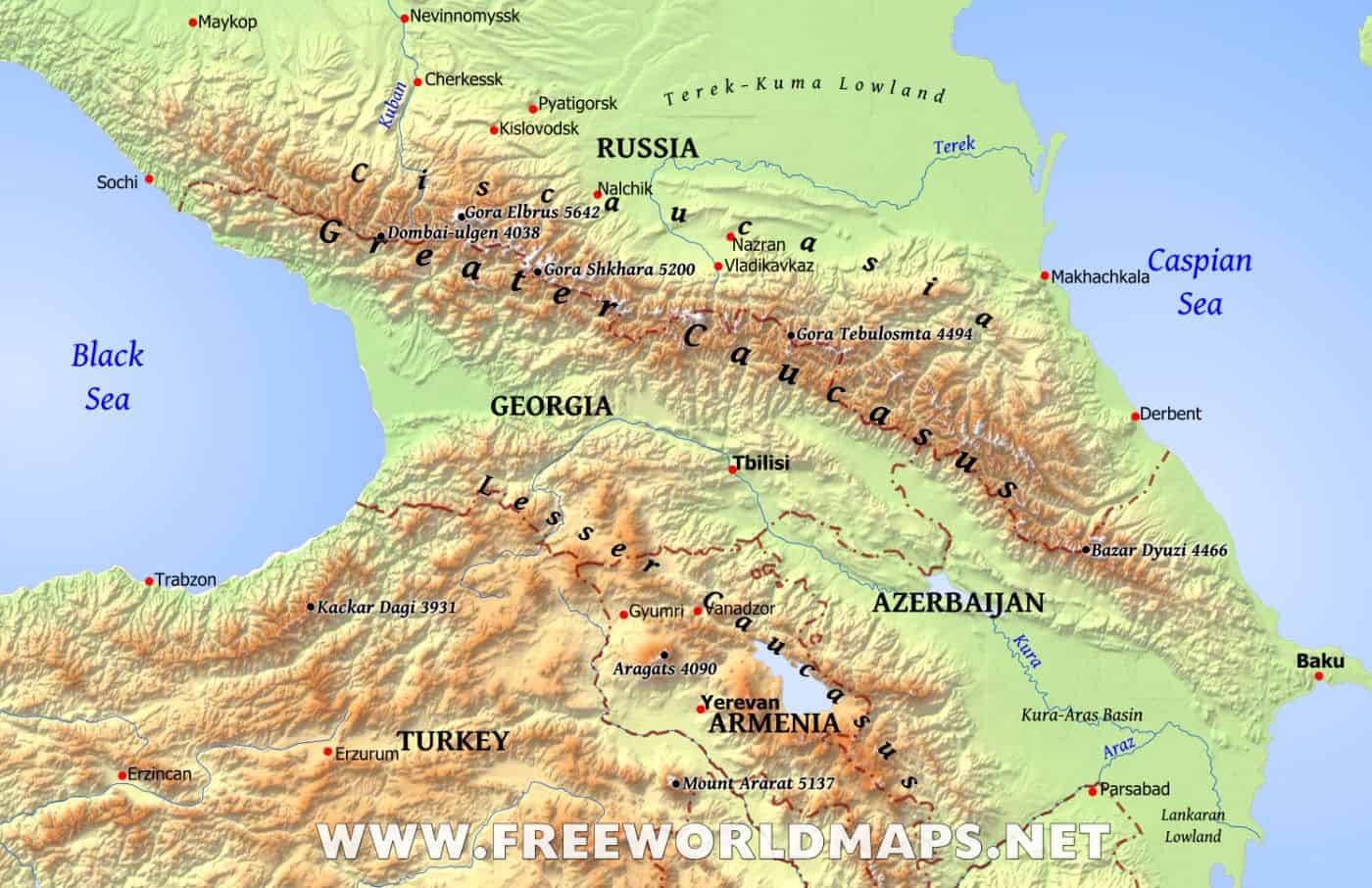
Georgia is the gateway to Western Asia. It’s a Christian Orthodox country bordered by the Islamic republics of Azerbaijan and Turkey with Russia still looming hauntingly to the north and Armenia peacefully to the south. Despite gaining independence in 1991, Georgia has two breakaway republics under Russian control called South Ossetia and Abkhazia. Mysterious and foreboding, they are like Austin and the panhandle telling the State of Texas to take a hike and do not enter.
The leader

Unlike other former Soviet republics enjoying prosperity such as Czech Republic and Lithuania, Georgia can’t find its serenity, even 27 years after communism. It’s basically run by its richest man, a former Soviet oligarch named Bidzina Ivanishvili whose fortune equals one third of the country’s entire gross national product. He founded the Georgia Dream party that now rules the country with somewhat of an iron fist. Protests abound. Tents have been set up in front of the Soviet-era Parliament building, a must stop on the Tbilisi walking tour. Protests and strikes are coming as common as street construction. As recently as May 12, 4,000 people protested the overnight drug raid of two nightclubs by setting up camp in front of Parliament and dancing well past midnight. Earlier this month, prime minister Giorgi Kvirikashvili resigned.
On paper, Georgia seems to have escaped the post-communist economic collapse experienced in much of mother Russia. Unemployment has dropped steadily since a 2009 high of 16.9 percent to 12. Its inflation rate is only 2.4 percent, and it’s second among all former Soviet republics in foreign investment.
But talk to the people and their dreams from the early days of democracy have yet to be reached.
Republic of Georgia’s problems
With St. George looming above and the start of a warm summer settling in on a well-lit early evening, I sat down in one of the many outdoor bars ringing Freedom Square with Nika Tsiklauri. Short, fit, with dark, wavy hair and glasses, the 34-year-old has worked in a bank’s credit card office for 10 years and makes $10,000 a year. For extra money he rents out his family’s two extra rooms up the street as an AirBnB.
“There are many poor people in Georgia,” he said as we sipped an industrial-tasting Georgian beer called Taglaura. “They’re either poor because there aren’t enough high-income jobs or there are no jobs.”
He talked about how Mikheil Saakashvili took over in 2003 at the end of communism and “built the city from ruins.” Saakashvili took a pro-tourism, pro-West slant. He expelled corrupt politicians and attracted Western investments. He reconstructed old, crumbling districts such as the area around Freedom Square which is now one of the heartbeats of Tblisi’s pulsating nightlife.
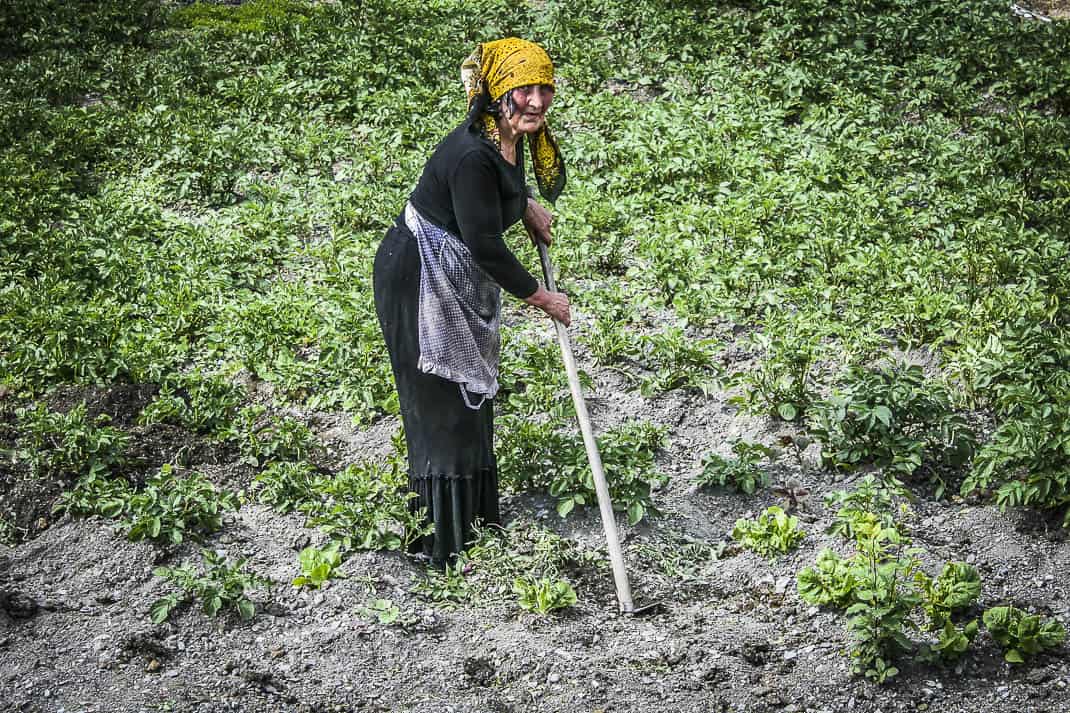
But in 2008 Saakashvili’s military lost a costly war with Russia over South Ossetia. Bitter and defensive, he began governing with an autocratic air and became intolerant of opposition, thus ushering in the likes of Ivanishvili. Many feel the country is regressing.
“He promised people that the development of Georgia will be much faster so everything will be much better but some promises were not kept,” Tsiklauri said. “Like many people in Georgia, like 30 percent of Georgian people think he’s a man of Russia. He’s not interested in politics. He has billions of dollars. But he still feels he maintains his power and it will continue but it comes from Russia.”
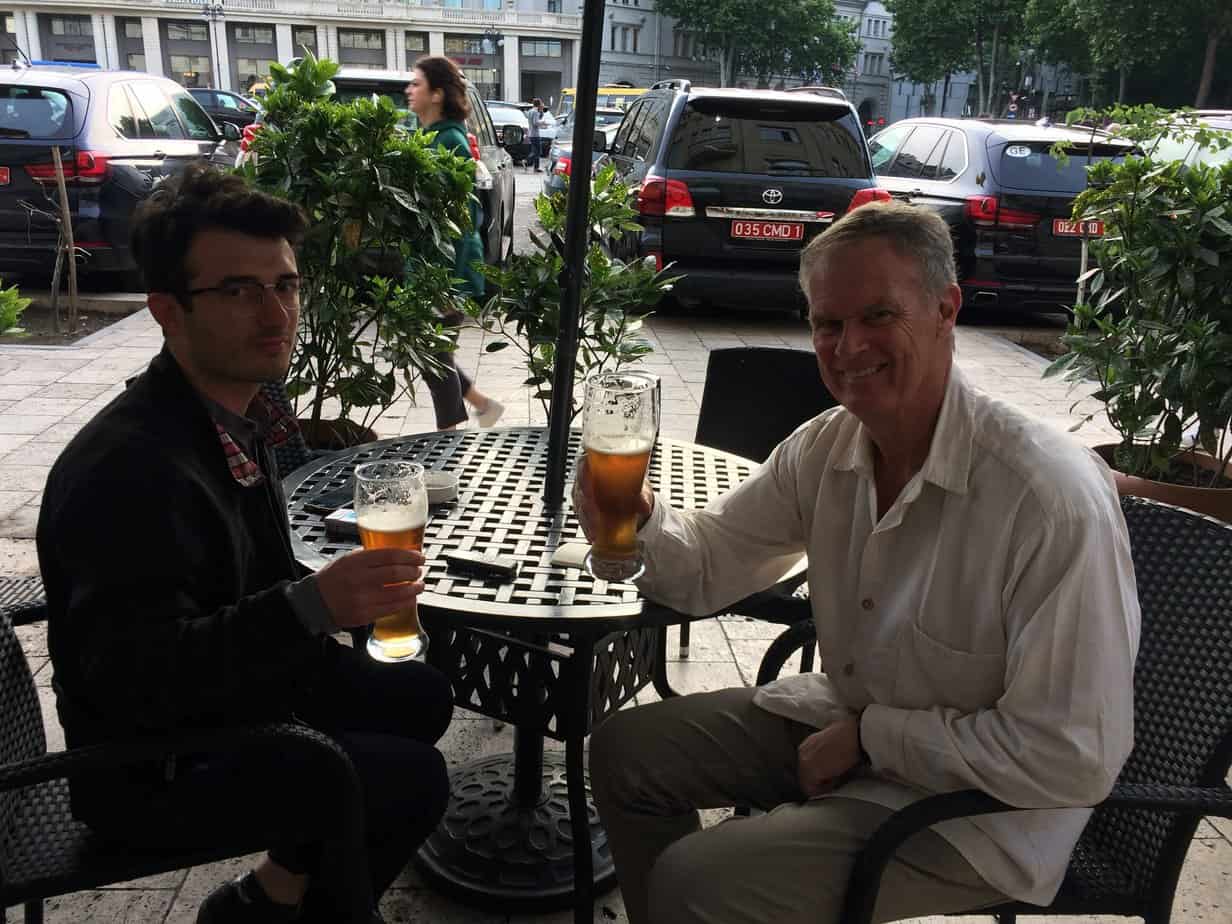
Georgia is a classic case of how politics, egos, power and crisscrossing economic systems can stain an otherwise idealistic landscape. Like blood stains on a chef’s apron, Georgia marches on touting its food and wine and mountains. They put on a happy face for travelers and dish out grub, booze and scenery that we’ll all remember much more than resigning government officials, their faces masks of shame.
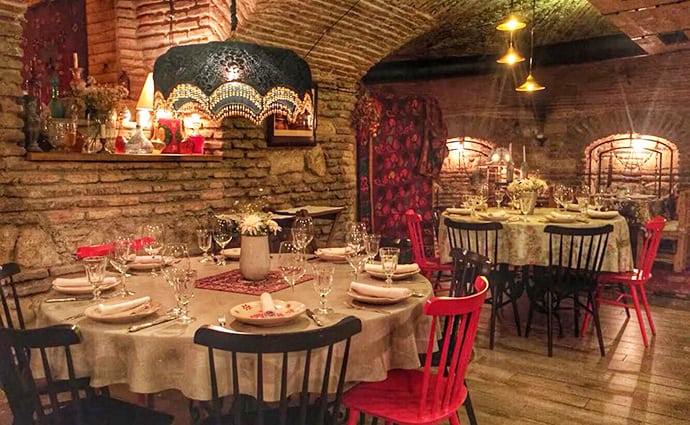
Georgian food
I became aware of Georgian cuisine on my first trip to Russia in 2005. My contacts in Moscow glowed about their nights out in the Georgian restaurants scattered around one of the world’s fastest-growing restaurant cities. I joined them and marveled at its grilled meats, semi-sweet red wine and khachapuri, Georgia’s signature thick, gooey cheese pie.
Thirteen years later, I took the recommendation of a Tbilisi friend and dined at Barbarestan, a classic old Georgian restaurant that recalls images of pre-revolutionary Russia when the wealthy bourgeoisie dined in places like this. I walked across huge throw rugs on wooden floors under a vaulted brick ceiling with lanterns holding burning candles. Waiters dashed around in white dress shirts and suspendered trousers.
A waiter came over and handed me the cookbook. I thought it was going to fall apart in my hand. It was from 1914 and the inspiration for the restaurant 2 ½ years ago after a man found the book at Dry Bridge, Tbilisi’s open air flea market. Of the 807 recipes listed, Barbarestan makes 125 of them. The original cookbook dating back to 1874 is even more fragile and is under lock and key.
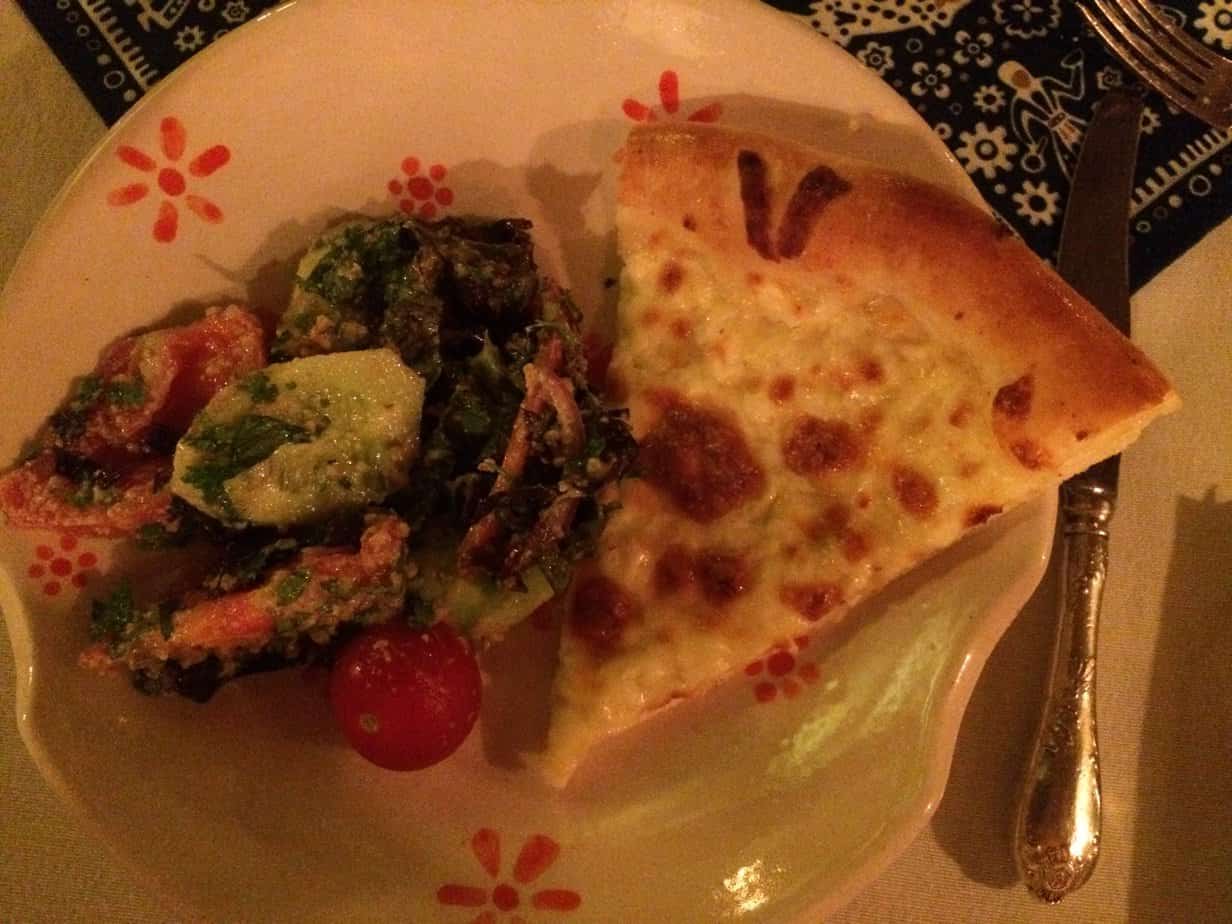
I ordered the Lazuri khachapuri, a big, round cheese pie with double cheese on top. It looks like a small, thick, Chicago-style pizza. Instead, its filled with Georgia’s salty gouda-style cheese. I tired of the cheese during hikes but baked in a pie, to go along with another Georgia classic, its walnut salad with sunflower oil, it was a great way to jump into a gastronomic paradise. The best part? The whole meal, including two glasses of wine, was all of 60 lari (about 21 euros).
Georgian wine
Yes, as in Italy, no matter how depressed Georgians get about the state of their country, they always have dinner to look forward to. It all starts with wine which is apropos as Georgia is where wine began. It’s true. Archaeologists have found remnants of clay pots here dating back 8,000 years. They were used to ferment wine underground, making Georgia the birthplace of wine, a handle Georgians are never too modest to point out.
The center of Georgian wine country is Kakheti, Georgia’s far east region where sun-splashed wine vineyards share space with beautiful churches and castles, all with snow-covered mountains as a backdrop. I took a marshrutka, kind of a large Volkswagen bus and Georgia’s main mode of public transport, about two hours to Telavi, the base for wine tasting.
Wine tasting in Georgia isn’t like in Tuscany or Napa Valley. It’s smaller scale in terms of number, facilities and popularity. The Telavi area has about 20 commercial wineries, all within a cheap taxi ride of each other. Many of the wineries were built during communism, meaning you have blockish, concrete, Soviet-style architecture as opposed to the castle-like fortresses and villas of wineries in California and Italy. In two days of wine tasting, I saw only two other customers, both British expats living in Georgia.
But in terms of quality, Georgian wine can share the table with the Italian reds and California whites. Any day. Georgia concentrates on three kinds of wines: dry reds, semi-sweet reds and sparkling wines. The 2015 Okro’s Wines Mtsvano Pet-Nat was voted one of the top 10 wines in the world by Esquire, and the number of other awards I saw covered the entire wall of the Telavi Wine Cellar.
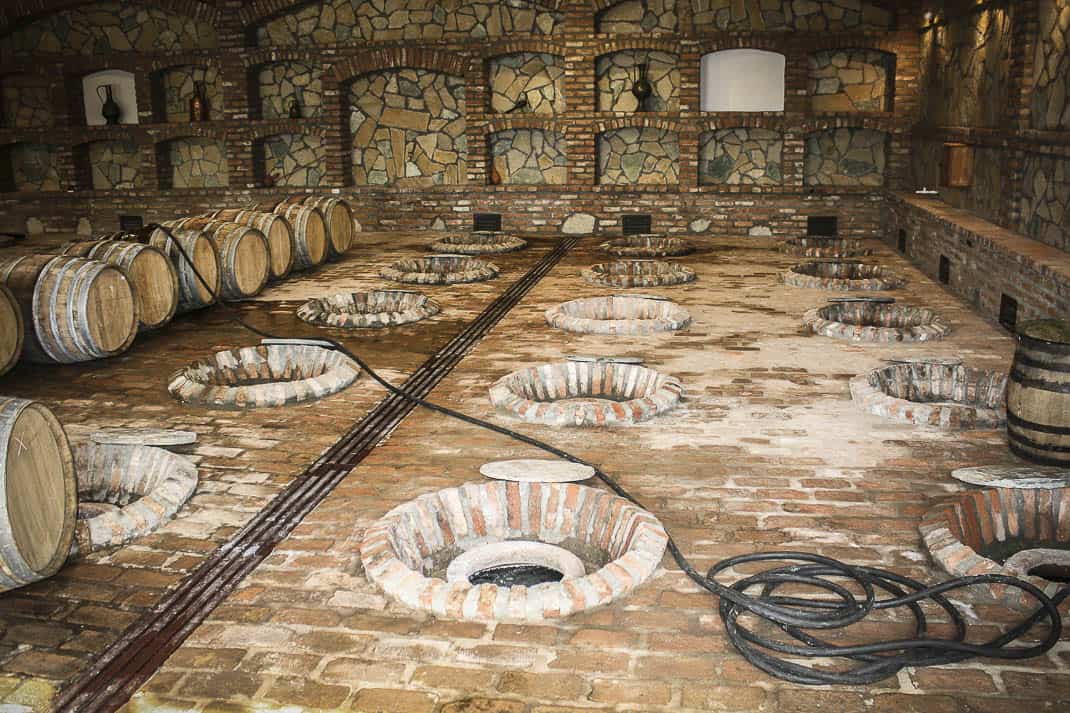
And yes, most still use the same methods as 8,000 years ago when mankind, dressed in animal furs, raised toasts to celebrate the end of the last Ice Age. Almost every winery had a room with round deep holes where they buried the clay pots, called qvevri, to ferment the wine six months, just as their ancestors did. The end result is an all-natural wine without the mass sulfites and preservatives of American wine. At my last wine tasting, a medium-sized winery called Vaziani Company, I tasted 10 wines, all about half a glass each. Yet the next morning, I didn’t have a headache.
I couldn’t walk, but I didn’t have a headache.
Wine production in Georgia goes beyond the commercial wineries which are exporting all over the world, thanks to a Russian embargo, improved marketing and savvy travel writers. Many families produce wine in their own back rooms.
I visited Irakli Rostomashvili who restarted the family wine business, called Rostomaant Marani, after the communists came in 1921 and took over all wine production. He has a small stone tasting room next to a room of six qvevri. Rostomashvili epitomizes the Georgian love affair with wine.
Over a glass of his best-selling Rkatsiteli, a dry white wine, he said, “I like wine. For me, everything is wine. Without wine, everything is nothing.”

Hiking scene
One of Georgia’s best attributes is after two days of drinking wine and eating cheese pie, it’s not hard to work it off. I took a five-hour marshrutka ride to the town of Kazbegi, the heart of the old Georgian Military Highway and the entry point for the spectacular Caucasus. Hiking in Georgia is hiking off the beaten path. This isn’t the Colorado Rockies where signage resembles something off an L.A. freeway. It’s not the Alps where hikers sometimes outnumber sheep.
It’s often just you — and a path, straight up and straight down.
However, the peaks are more beautiful than the Alps and Rockies, if not as high as in Colorado. But six are more than 5,000 meters and the range stretches 1,200 kilometers from the Black to the Caspian seas.
They’re covered in snow all year round and they are spectacularly beautiful. Hovering over Kazbegi, a pretty little town of 2,500 at 1,750 meters elevation near the Russian border, is Mt. Kazbek, a gorgeous 5,047-meter extinct volcano. Just below it, like a jewel on a necklace, sits Tsminda Sameba (Holy Trinity) Church. It’s a 1,000-meter climb to the church and then you can hike all the way to the Kazbek base camp with gorgeous views back to the church and town below.
Not believing it could get better, it did. After two days of hiking, I flew from Tbilisi to Mestia, home of the Great Caucasus in the far north. The 45-minute flight alone, just below the mountain peaks, rivaled the 1987 flight I took past the Himalayas into Kathmandu. Jagged, individual peaks, all covered in snow, outlining green meadows with specks of villages and wind-swept flurries off mountaintops beyond.
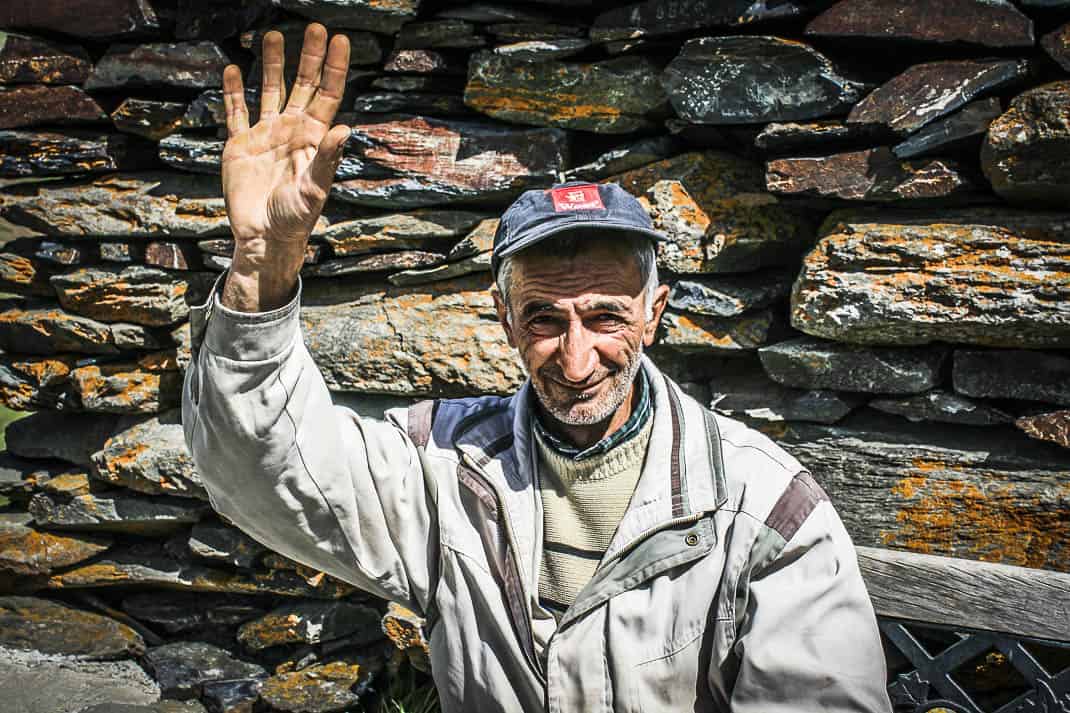
In Mestia, over three days, I hiked up to a ski resort, took a chair lift back up the next day and hiked to a TV tower then hiked 1,000 meters straight up to a legendary cross that overlooks the entire town. Everywhere I went, every turn I took, every step I made, I had a panorama view of an incredible snow-covered mountain range. In few spots did I see people. It was like walking alone through the Ice Age — except for the daypack full of food.
Each night I made the nightly pilgrimage to Leila’s, a restaurant-bar where in the morning I’d beef up for hikes with khikhlinko, thick, homemade Georgian bread fried with scrambled eggs, a dish so good you wonder why U.S. ski resorts haven’t picked up on it. It’s a native dish of the Svans, the ethnic group for which the Svaneti region is named. Tall stone towers the Svans used for defense are scattered around Mestia like middle fingers.
The Svans were known for taking blood revenge but you wouldn’t know it by the marvelous native dance performances they did every night inside Leila’s. A five-man band playing native songs on drums and guitars while a young guy in long, curly black hair twirled around the floor like a Swirling Dervish. I don’t like ethnic dance performances much. They seem too fake and stilted, packaged entirely for tourists. But in this isolated town in the heart of the Great Caucasus, with so many locals hanging out, it had an air of authenticity. Watching with a big glass of Saperavi, Georgia’s most famous wine, certainly helped me get into the mood.
The nine-hour marshrutka ride back to Tbilisi revealed the old Georgia that the new Georgia has failed to modernize. We chugged down in elevation and came across crude apartment houses with peeling paint and barred windows in small towns long past their usefulness. Factories that once churned out whatever product was essential in Soviet households lay barren and abandoned. Old women bundled up like babushkas wobbled unsteadily along dusty streets.
A young Georgian
Once back in Tbilisi I met Anna Surguladze, 22, and her friend, Demetre Nikabadze. I know Surguladze from Rome’s Language Tandem Meetup group where we all sit around and butcher each other’s languages once a week. She represents the new Georgia where everyone under 30 is fluent in English after 11 years of study and everyone over 40 can’t count to three. She is a financial analyst but unlike many of her brethren, she doesn’t want to leave Georgia to find a better life.
“I have experience living abroad for a couple of years,” she said. “I want to have some impact on my society.”
We met at Cafe Le Toit on one of the many bustling side streets off Freedom Square. A gloomy waitress, representative of the generally lousy restaurant service around the country, couldn’t put a damper on the lovely trappings. Cafe Le Toit looks like your grandmother’s living room with big, comfortable chairs, flowered wallpaper and a gaudy chandelier hanging over it all. On the quaint balcony, I asked Surguladze what was Georgia’s biggest problem.

“Education and economics,” she said. “It’s an education system that’s really outdated. It’s old. Nowadays today’s youngsters are much more free than their ancestors were, than their parents were, because they were raised in the Soviet era and they were taught to think the way it was written in their books. Nowadays in the schools these people teach youngsters, youngsters who are more free and liberal.
“These people who are the teachers, who are their parents, they’re from the Soviet Union. They don’t know what freedom is. They don’t teach children how to analyze things, how to think more openly. They just expect from the children to obey the rules. They don’t teach them creative thinking or help them to become grownups and about life.”
Later, Surguladze took us on a field trip up and down the narrow cobblestone roads in Tbilisi’s old town. With a flight at 3:30 a.m., my game plan was to pull an all-nighter, an easy task in Tbilisi. We wound up in a dive underground brick bar called Zoestan where I continued my tour across Georgia’s wine map, however unsteadily.
Young Georgians seem alive. They laugh. They go out. They dream. They protest. At least, they do much more than their parents did. Surguladze said there is a lot I didn’t see in two weeks.
“Many families are almost nearly starving,” she said. “They don’t have sufficient money to provide for themselves and their kids. Youngsters want to leave Georgia mainly because they think it’ll be better in Europe, with a better perspective.”
As I carried my backpack into Freedom Square to catch a cab, I said goodbye to Georgia, to the wine stores I walked by so many times and the teetering revilers I left behind. I took a last look at St. George, high atop the horse, still shining in gold well past midnight. He slew the dragon in the statue, leaving me with one lasting thought.
Georgia still has so many dragons to slay.


June 28, 2018 @ 9:36 am
So glad you wrote this article about a country I’ve read little about. I look forward to your additional articles. I’m going straight to a map of Georgia now. Would you consider including a map in your articles with your route marked? Just an idea.
June 28, 2018 @ 1:31 pm
We had a student from Georgia at St. John’s College and he became a seller of Georgian wines. I loved the Rose which I don’t normally like unless it is French and dry. Georgia’s is great. A group of students from SJC went to Georgia to help them set up a classical study seminar based program like that of St. John’s. I wondered if it is still going. Thanks for the info on Georgia.
Alice Chambers (Lisa’s Mom)